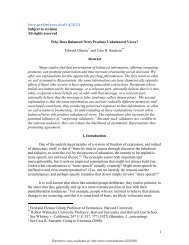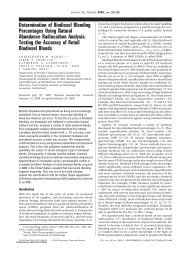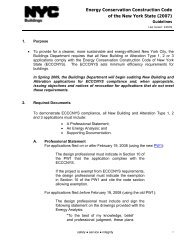GREENHOUSE GAS EMISSIONS - The Sallan Foundation
GREENHOUSE GAS EMISSIONS - The Sallan Foundation
GREENHOUSE GAS EMISSIONS - The Sallan Foundation
You also want an ePaper? Increase the reach of your titles
YUMPU automatically turns print PDFs into web optimized ePapers that Google loves.
facilities, etc.), as well as methane generated during the wastewater treatment process.<br />
Because these facilities tend to use large amounts of electricity, natural gas, and fuel<br />
oil, their emissions inventory data are separated from the buildings inventory for further<br />
analysis. All such facilities (located both in the City and in the watershed in upstate New<br />
York) are controlled and operated by DEP, although DCAS compiles the financial<br />
records.<br />
Methane generated during the treatment of wastewater was quantified and provided by<br />
DEP. While most of the methane generated during the treatment process is either flared<br />
or used productively in the treatment process, a small amount does escape into the<br />
atmosphere through system leaks or malfunctions. As anaerobic digester gas<br />
production at the City’s water pollution control plants increased by roughly 15 percent<br />
over the last ten years, an annual average rate of increase in methane emissions of 1.5<br />
percent was assumed and applied to both background years and the forecast year.<br />
11. Solid Waste<br />
All solid waste collected from City buildings and offices in Fiscal Years 1995, 2001, and<br />
2006 was transported to landfills along with solid waste from New York City as a whole.<br />
Once it is brought to the landfill (Fresh Kills Landfill in 1995 or landfills outside the city in<br />
2001 and 2006), determining the origin of the waste is impossible. <strong>The</strong>refore, an<br />
alternate method for estimating the amount of greenhouse gas emissions from this<br />
sector was used.<br />
<strong>The</strong> New York City Department of Sanitation conducted a Waste Composition Study in<br />
1990 and found that each New York City government office employee generated 0.54<br />
metric tons of solid waste annually, recycling 0.05 metric tons (almost all paper) and<br />
sending 0.49 metric tons to landfill. 17 Because not all employees work in an office<br />
setting on a daily basis, DEP, DPR, and DOT were surveyed to determine the<br />
percentage of their employees who work in an office and therefore generate solid waste<br />
that can be considered typical of a government office worker. This number of<br />
employees was added to the total number of office employees, as reported in the<br />
Mayor’s Management Report. <strong>The</strong> balance from these three agencies was added to the<br />
number of non-office employees (uniformed) workers from FDNY, NYPD, DOC, and<br />
DSNY. Each category of employee (office employee and non-office employee) was<br />
entered into the CACP software separately, with the number of employees multiplied by<br />
the amount of waste landfilled annually per employee to arrive at the total tons landfilled<br />
in Fiscal Years 1995, 2001, and 2006. Waste share percentage variables were set in<br />
the CACP software for each employee category, based on DSNY’s 1990 Waste<br />
Composition Study. This document was used to obtain a breakdown of the percentage<br />
by weight of different waste types for office employees, while the ICLEI recommended<br />
default waste share percentages were entered for uniformed employees. As seen in<br />
Table 2, the primary difference is that office workers are assumed to generate far more<br />
paper than non-office workers. This change results in different levels of greenhouse gas<br />
emissions from the decomposition of this waste for each employee category.<br />
17 SCS Engineers (1992) New York City Waste Composition Study (1989-1990), DSNY.<br />
34







